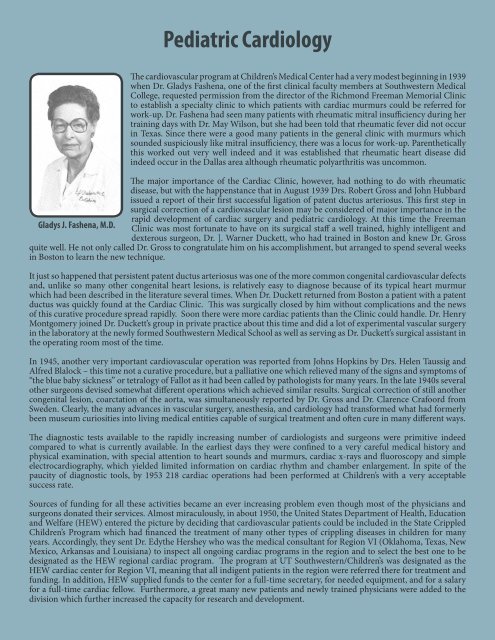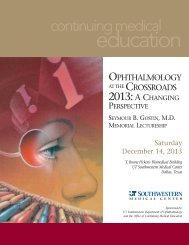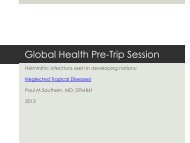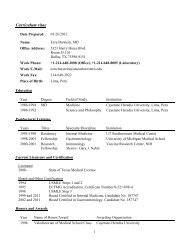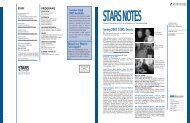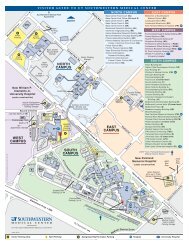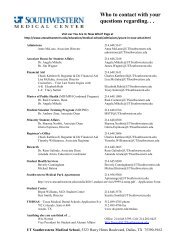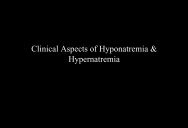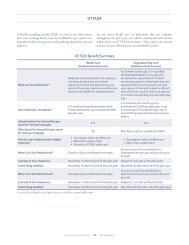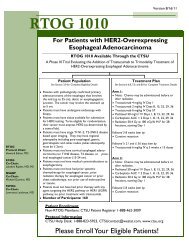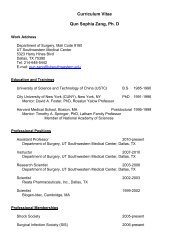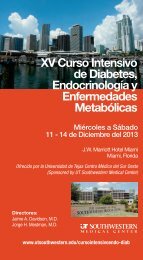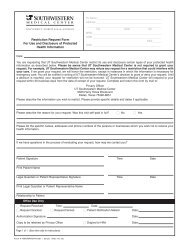Pediatric Cardiology - UT Southwestern
Pediatric Cardiology - UT Southwestern
Pediatric Cardiology - UT Southwestern
You also want an ePaper? Increase the reach of your titles
YUMPU automatically turns print PDFs into web optimized ePapers that Google loves.
<strong>Pediatric</strong> <strong>Cardiology</strong><br />
The cardiovascular program at Children’s Medical Center had a very modest beginning in 1939<br />
when Dr. Gladys Fashena, one of the first clinical faculty members at <strong>Southwestern</strong> Medical<br />
College, requested permission from the director of the Richmond Freeman Memorial Clinic<br />
to establish a specialty clinic to which patients with cardiac murmurs could be referred for<br />
work-up. Dr. Fashena had seen many patients with rheumatic mitral insufficiency during her<br />
training days with Dr. May Wilson, but she had been told that rheumatic fever did not occur<br />
in Texas. Since there were a good many patients in the general clinic with murmurs which<br />
sounded suspiciously like mitral insufficiency, there was a locus for work-up. Parenthetically<br />
this worked out very well indeed and it was established that rheumatic heart disease did<br />
indeed occur in the Dallas area although rheumatic polyarthritis was uncommon.<br />
The major importance of the Cardiac Clinic, however, had nothing to do with rheumatic<br />
disease, but with the happenstance that in August 1939 Drs. Robert Gross and John Hubbard<br />
issued a report of their first successful ligation of patent ductus arteriosus. This first step in<br />
surgical correction of a cardiovascular lesion may be considered of major importance in the<br />
rapid development of cardiac surgery and pediatric cardiology. At this time the Freeman<br />
Gladys J. Fashena, M.D. Clinic was most fortunate to have on its surgical staff a well trained, highly intelligent and<br />
dexterous surgeon, Dr. ]. Warner Duckett, who had trained in Boston and knew Dr. Gross<br />
quite well. He not only called Dr. Gross to congratulate him on his accomplishment, but arranged to spend several weeks<br />
in Boston to learn the new technique.<br />
It just so happened that persistent patent ductus arteriosus was one of the more common congenital cardiovascular defects<br />
and, unlike so many other congenital heart lesions, is relatively easy to diagnose because of its typical heart murmur<br />
which had been described in the literature several times. When Dr. Duckett returned from Boston a patient with a patent<br />
ductus was quickly found at the Cardiac Clinic. This was surgically closed by him without complications and the news<br />
of this curative procedure spread rapidly. Soon there were more cardiac patients than the Clinic could handle. Dr. Henry<br />
Montgomery joined Dr. Duckett’s group in private practice about this time and did a lot of experimental vascular surgery<br />
in the laboratory at the newly formed <strong>Southwestern</strong> Medical School as well as serving as Dr. Duckett’s surgical assistant in<br />
the operating room most of the time.<br />
In 1945, another very important cardiovascular operation was reported from Johns Hopkins by Drs. Helen Taussig and<br />
Alfred Blalock – this time not a curative procedure, but a palliative one which relieved many of the signs and symptoms of<br />
“the blue baby sickness” or tetralogy of Fallot as it had been called by pathologists for many years. In the late 1940s several<br />
other surgeons devised somewhat different operations which achieved similar results. Surgical correction of still another<br />
congenital lesion, coarctation of the aorta, was simultaneously reported by Dr. Gross and Dr. Clarence Crafoord from<br />
Sweden. Clearly, the many advances in vascular surgery, anesthesia, and cardiology had transformed what had formerly<br />
been museum curiosities into living medical entities capable of surgical treatment and often cure in many different ways.<br />
The diagnostic tests available to the rapidly increasing number of cardiologists and surgeons were primitive indeed<br />
compared to what is currently available. In the earliest days they were confined to a very careful medical history and<br />
physical examination, with special attention to heart sounds and murmurs, cardiac x-rays and fluoroscopy and simple<br />
electrocardiography, which yielded limited information on cardiac rhythm and chamber enlargement. In spite of the<br />
paucity of diagnostic tools, by 1953 218 cardiac operations had been performed at Children’s with a very acceptable<br />
success rate.<br />
Sources of funding for all these activities became an ever increasing problem even though most of the physicians and<br />
surgeons donated their services. Almost miraculously, in about 1950, the United States Department of Health, Education<br />
and Welfare (HEW) entered the picture by deciding that cardiovascular patients could be included in the State Crippled<br />
Children’s Program which had financed the treatment of many other types of crippling diseases in children for many<br />
years. Accordingly, they sent Dr. Edythe Hershey who was the medical consultant for Region VI (Oklahoma, Texas, New<br />
Mexico, Arkansas and Louisiana) to inspect all ongoing cardiac programs in the region and to select the best one to be<br />
designated as the HEW regional cardiac program. The program at <strong>UT</strong> <strong>Southwestern</strong>/Children’s was designated as the<br />
HEW cardiac center for Region VI, meaning that all indigent patients in the region were referred there for treatment and<br />
funding. In addition, HEW supplied funds to the center for a full-time secretary, for needed equipment, and for a salary<br />
for a full-time cardiac fellow. Furthermore, a great many new patients and newly trained physicians were added to the<br />
division which further increased the capacity for research and development.
One of the first projects at this point was to develop a cardiac catheterization program which initially involved measuring<br />
pressures and obtaining blood samples from various chambers of the heart under x-ray visualization and demonstration<br />
of the course of intracardiac circulation by injecting radiographic dye and then making biplane angiograms of the dye as it<br />
traversed the heart and adjoining vessels. This required a special suite of rooms, sophisticated x-ray equipment, and special<br />
laboratory and working space for the staff. Most importantly, it required a physician director who was trained in the art and<br />
science of this new technique. This crucially important position was filled by Dr. Kathryn Willis, one of the program’s own<br />
graduates who was trained both in pediatrics and internal medicine and who also had the distinction of serving a year of<br />
fellowship under Dr. Rudolph Bing, one of the pioneers in cardiac catheterization. The laboratory was completed and staffed<br />
by the mid-1950s and has served thousands of patients since.<br />
The HEW cardiac fellowship also proved to be a useful and popular training program. The first fellow was Dr. Alvis F.<br />
Johnson, who served from 1952 through June 1954 and then proceeded to private practice in pediatric cardiology as<br />
a member of the medical school staff for 30 years. Dr. Lynn Mahony has been the director of the pediatric cardiology<br />
fellowship program since 1996. The three-year program recruits two new fellows each year. All pediatric cardiology and<br />
CVICU attendings are actively involved in the fellows’ training as they rotate through the different areas of the Heart<br />
Center. The department also offers training to those who are looking to do a fourth year of fellowship.<br />
It had been obvious for years that most congenital cardiac defects could not be repaired without intracardiac surgery.<br />
A number of different modalities had been tried and found wanting. In the early 1950s, Dr. C. Walton Lillehei and his<br />
Minnesota co-workers succeeded in improvising a heart-lung substitute using the patient’s father with the same blood<br />
type as a “living pump.” After several of these procedures proved successful in subsequent patients, research began in<br />
many cardiac centers both here and in England to develop a totally safe non-human heart-lung machine. All of the Dallas<br />
cardiac centers took part in this effort and, in 1957, Drs. Ben Mitchell and Milton Davis performed the first open heart<br />
surgery in Dallas at St. Paul hospital using the jointly developed pump. This was rapidly followed by similar procedures at<br />
Baylor, Parkland, and Methodist hospitals, and finally in 1964 at Children’s.<br />
During the 20 odd years which elapsed from the first closed heart procedure performed at Children’s to the sophisticated<br />
open heart techniques, there was enormous growth in other areas including expansion of the <strong>Southwestern</strong> Medical School<br />
pediatric faculty and student body, an increase in patient load at Children’s, and growth in the size of the house staff. In<br />
1967, Children’s moved to a new, larger building adjacent to the medical school and Parkland Hospital. The new surgical<br />
area included a special cardiac operating room and a new cardiac catheterization laboratory. More pediatric cardiologists<br />
were also needed and the following physicians spent significant periods of time as full-time members of the cardiology<br />
division: Walton Gersony, M.D., William W. Miller, M.D., David E. Fixler, M.D., W. Pennock Laird, M.D., Edgar Newfeld,<br />
M.D., Mark D. Parrish, M.D., Lynn Mahony, M.D., Nancy Ayres, M.D., Tim Feltes, M.D., Sarah Blumenschein, M.D., Ellen<br />
Weinstein, M.D., Thomas Zellers, M.D., Resai Bengur, M.D., and William Scott, M.D.<br />
Many surgeons who opened their offices in the Dallas area were trained in thoracic and cardiovascular surgery. Many<br />
of these became part of the clinical faculty at the medical school and had surgical privileges at Children’s. However,<br />
it was not until the early 60s that <strong>UT</strong> <strong>Southwestern</strong> obtained a full-time academic head of the Division of Thoracic<br />
and Cardiovascular Surgery in the person of Dr. Hugh E. Wilson, III. This exemplary individual contributed greatly<br />
to the cardiovascular program at Children’s by being an innovative surgeon and a gifted teacher.<br />
Subsequently, several other talented cardiovascular surgeons contributed to the program including<br />
Drs. Maurice Adam, Winfred Sugg, Roger Ecker, Mel Platt, Larry Mills, Tracy Schreiber, and Steve<br />
Leonard. In January 1978, Dr. Hisashi Nikaidoh joined the staff. He was the first experienced<br />
cardiac surgeon who limited his practice to pediatric cases and, therefore, was geographically fulltime<br />
at Children’s. During the 1980s, Dr. Nikaidoh brought to Dallas several<br />
innovative procedures including the use of homografts (donor arteries)<br />
for pulmonary atresia, the Fontan procedure for single ventricles, and the<br />
arterial switch procedure and translocation procedure for transposition. In<br />
January 1988, the experienced heart transplant surgeon, Dr. W. Steves Ring,<br />
became Chief of thoracic surgery at the medical school. Shortly thereafter he<br />
W. Steves Ring, M.D. performed the first heart transplant at Children’s on a six-month-old infant.<br />
Dr. William Weaver Miller served as the Director of the Division of <strong>Cardiology</strong> at <strong>UT</strong> <strong>Southwestern</strong><br />
1970 to 1976, followed by Dr. David Fixler from 1976 to 2004.<br />
David Fixler, M.D.
In 1986, as a result of the generous contributions of the David Bruton, Jr., Charitable Trust and the Harry S. Moss Heart<br />
Trust, plans were formulated to develop an institute at Children’s dedicated to caring for families whose children had heart<br />
disease. These plans came to realization in November 1990 when The Frank S. and Mary Jane Ryburn Heart Institute<br />
opened in the new east tower at Children’s Medical Center.<br />
When Dr. Fixler stepped down as Division Director in 2004, the division had grown to 14 faculty and five post-doctoral<br />
fellows. Annual inpatient consultations exceeded 700 and outpatient evaluations totaled more than 5,600.<br />
Dr. William Scott, a member of the pediatric cardiology faculty since 1990, assumed the<br />
role of Division Director in 2006. Under his direction, the division continues to expand<br />
to meet the increasing pediatric cardiac service needs of the region. By 2009, there were<br />
23 faculty members and nine fellows. Construction of a new Heart Center was under<br />
way to bring all cardiac services together on one floor of the hospital, beginning with a<br />
new 26-bed CVICU that opened in early 2009. Inpatients with cardiac disease received<br />
care in the new CVICU and a 22-bed telemetry/step-down unit. Care was provided<br />
for over 2,300 medical patients and 500 surgical patients, including 348 open cases and<br />
10 cardiac transplants. In addition, more than 7,800 patients were evaluated in the<br />
outpatient clinics at Children’s Dallas and the new Children’s Ambulatory Care Pavilion<br />
at Legacy.<br />
The division is committed to advancing clinical and basic research, with faculty involved<br />
in numerous NIH- and March of Dimes-supported projects, and is a source of education<br />
of new physicians and ongoing support of practicing physicians throughout the state.<br />
William A. Scott, M.D., M.S.<br />
<strong>UT</strong> <strong>Southwestern</strong> Academic College<br />
One of the first clinical faculty members at the new <strong>Southwestern</strong><br />
Medical College in the early 1940s, Gladys Fashena blazed trails in<br />
pediatrics. She did so even though her parents had thought her wish to<br />
become a doctor was a “wild idea.” The determined daughter of a New<br />
York City cork importer turned her dream into a reality by working<br />
her way through school. First she earned a bachelor’s degree from<br />
Hunter College, then a master’s degree from Columbia University, and<br />
finally her medical degree at Cornell Medical School in 1934.<br />
She joined Dallas’ Baylor Medical College faculty in 1939. When Baylor<br />
moved to Houston four years later, Dr. Fashena helped inaugurate <strong>UT</strong><br />
<strong>Southwestern</strong> and remained until her retirement nearly 40 years later. She became a full professor in 1949 and held<br />
the title of professor emeritus after her retirement until her death in 2000.<br />
Dr. Fashena was a pioneer in pediatric cardiology. Among the first to understand that newborns who were blue<br />
had congenital heart problems, she recruited a surgeon from Chicago to become the first Texas surgeon to operate<br />
exclusively on children’s hearts. She was the first full-time member of the pediatric faculty, and during her career<br />
of practicing and teaching, she established the pediatric cardiology department at Children’s Medical Center of<br />
Dallas. She was chosen as one of 10 outstanding college teachers in Texas to be designated a Piper Professor in<br />
1974. In 1976, she became the first female president of the Dallas County Medical Society.


